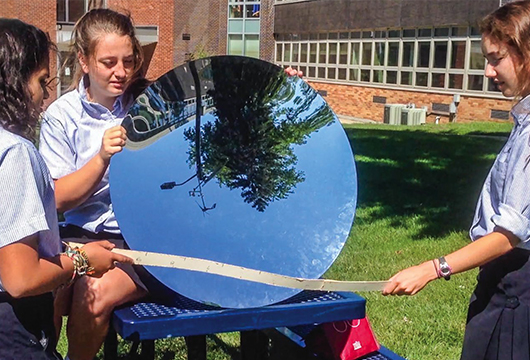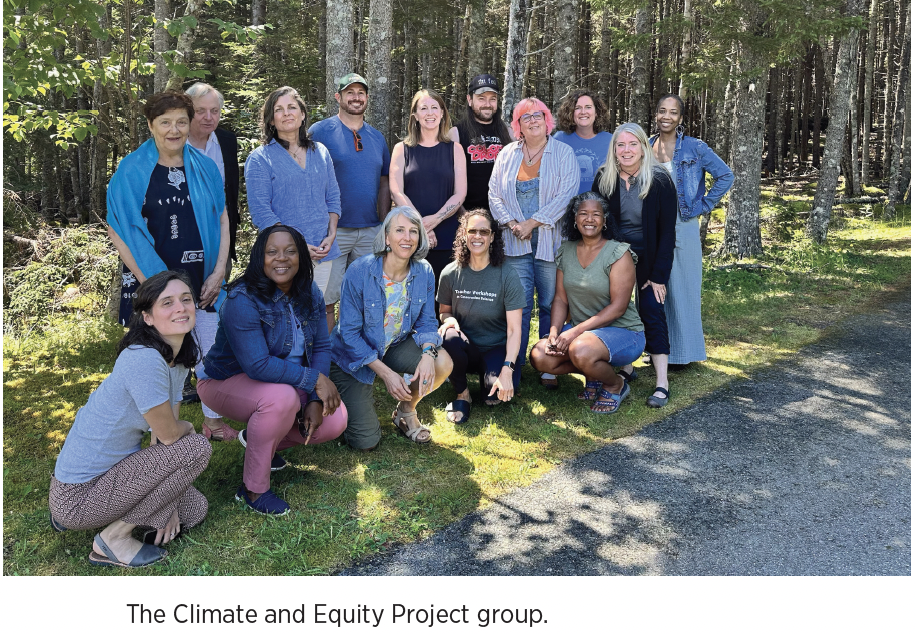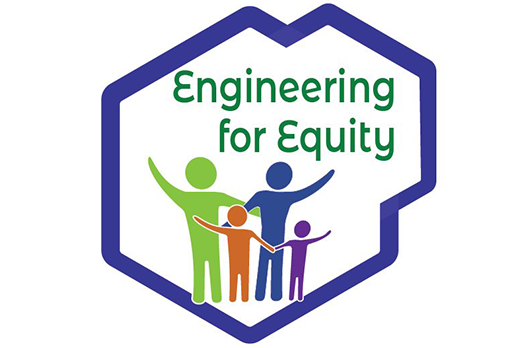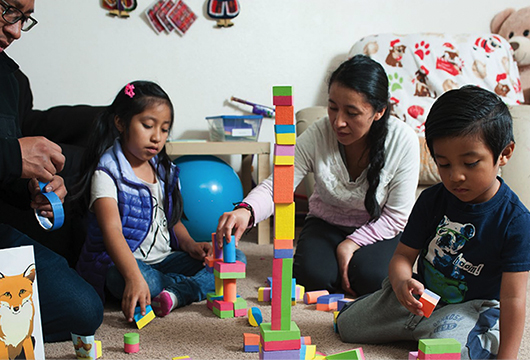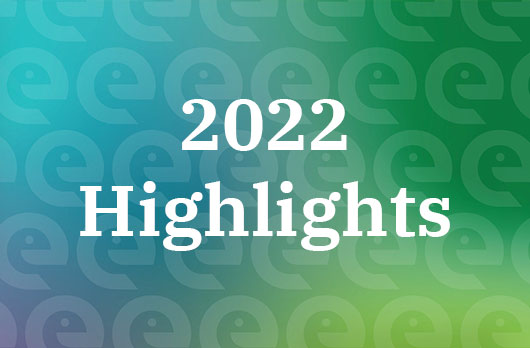TERC Blog
Innovate to Mitigate
Combatting Climate Change One Project Idea at a Time
The ecosystem of formal STEM education has always included activities such as science competitions and science fairs. Their special purpose is to provide students with opportunities to experience and practice science as it is practiced and experienced in the real world.
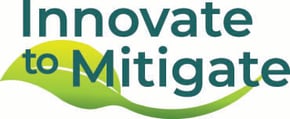
In the Innovate to Mitigate project, we design and host crowdsourced open innovation challenges for young people age 13–18 to develop methods for mitigating global climate change. The challenges invite students to participate in a global effort to reduce emissions, to engage with peers and with scientists about real science, and to take agency for their own learning.
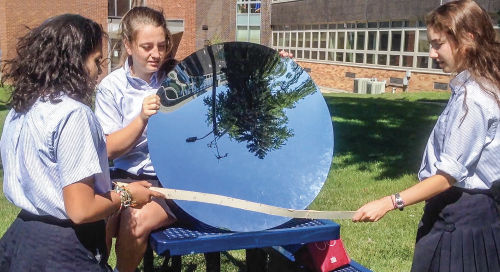 Figure 1. Testing a parabolic reflector to enhance the efficiency of a novel apparatus to produce biochar.
Figure 1. Testing a parabolic reflector to enhance the efficiency of a novel apparatus to produce biochar.
In this article, we describe the results from two pilot Challenges that ran in 2013–2014, and 2014–2015 (Puttick & Drayton, 2017). In total, 10 students participated from two international schools (China and Lebanon), one parochial school, one private school and 80 from public schools across the US. The median age was 16 and median grade level was 10th grade. Twenty-eight teams submitted videos and accompanying science papers (see their videos at Innovatepilot.videohall.com and Innovate2015.videohall.com).
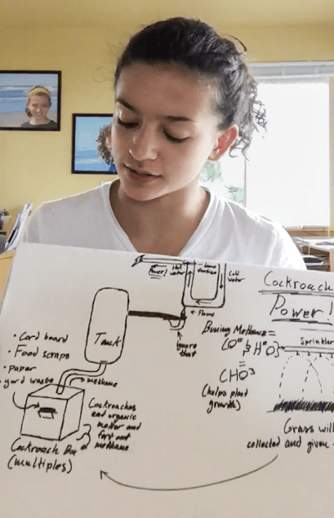
The Challenges are widely publicized through postings on social media, listservs, and emails. The project website features breaking stories about exciting mitigation research projects that inspire creativity and seed ideas from news outlets, links to YouTube videos, and reports in popular science blogs.
Teams develop a climate change solution over a period of several weeks, helped by a local coach (usually their teacher) with execution, problem-solving, and logistical challenges. They present their project through videos and papers posted to an online video forum, where each is judged by a panel of four scientists. Teams are awarded cash prizes for innovation, best video/paper presentation, and most engaged in discussion in the online forum. In addition, a community choice award is given to the project that receives the most likes.
Innovate to Mitigate is designed to engage a broad diversity of participants working collaboratively. They work in teams in an open-ended, goal-oriented way, yet the parameters of the challenge and a suite of tools and resources structure the problem space. The online cross-platform competition fully integrates social media to build a youth-led learning community around mitigation. It draws on crowdsourcing to elicit the best thinking of participant teams as many real-world crowdsourcing efforts do (King & Lakhani, 2013). It uses social media to support student participation, just as social media have increasingly facilitated the work of media practicing scientists (Henry, 2016).
Enhancing Learning Through Networking and Collaboration
We wondered how Innovate to Mitigate participants might benefit from working in a setting in which they interact with key collaborators (other teams, coaches, and experts). We were aware that researchers note several benefits that participants receive in traditional poster sessions: receiving feedback and networking with others, promoting communication skills and collaboration between group members, and creative assessment opportunities (Stroud & Falk 2015 provide several valuable references in this connection, including Aust & Kinnick, 1996; Johnson & Green, 2007; Stegemann & Sutton-Brady, 2009; Sisak, 1997). We are seeing that these same benefits accrue to participants in the Innovate competition.
Caring about and mitigating climate change motivated roughly half the students to participate, while half participated as part of a course designed by their teacher.
Twenty percent said they were motivated by the prize money. When asked to rate their learning at the end of the competition, an overwhelming majority of students reported that they had learned a moderate or great amount about climate change and about the specific area of their project. Over half of them provided detailed information about how the project experience had enhanced their learning.
At the beginning of the project I knew some general problems our world is facing and the basics of photosynthesis that occurs in plants. Now, as a result of the project, I know how artificial leaves are crafted and mimic photosynthesis, and how they can be used to mitigate CO2 emissions.
In both pilot studies, we gave teams access to Videohall, a social-media style platform designed for the sharing of posters and presentations. In reviewing interactions that occurred on the platform, our team was able to capture snapshots of deep learning across a wide range of domains. For example, the Photoelectrics team of three 10th graders in Maryland designed transparent solar cells as smartphone covers to continually charge phones during use, thus obviating the need for a plug-in charger. One of the judges raised a concern about the efficiency of the solar cell indoors, where light levels are lower. A team member responded:
[…] Some sources of indoor lighting, particularly halogen lamps, incandescent lamps, can emit a varied amount of ultraviolet energy providing some charge to the device. In fact, 70% of energy emitted by incandescent lamps consist of infrared energy. Common fluorescent lamps used today can still transfer ultraviolet energy with variable strengths depending on the proximity to the lamp. While the charge provided indoors will not be nearly as powerful as direct sunlight, some electric charge can be generated from indoor lamps and light leaking in through windows.
Another judge singled out the Photoelectrics team and explained their high rating for this project, writing:
The solar smartphone screen project did a very good job of integrating a power use problem into current technology. If they were able to implement this, it would circumvent people forgetting to use an external solar charger. Depending on power usage, I could see this technology, in conjunction with more efficient batteries, potentially removing the need to charge smartphones.
Overall, the power of the competition as a learning environment was amply demonstrated by the caliber of the projects the students produced, the depth of learning revealed in their posters, videos, and discussions, and the students’ own ratings of the competition experience. Furthermore, the pilots showed the potential for this type of competition to generate fresh and innovative ideas for carbon mitigation.
 Figure 3. Explaining how a mix of graphene, water-based paint, and tiny solar panel “chips” will generate energy to power a building. Solar energy is conducted from the solar chips via the paint to a capacitor.
Figure 3. Explaining how a mix of graphene, water-based paint, and tiny solar panel “chips” will generate energy to power a building. Solar energy is conducted from the solar chips via the paint to a capacitor.
The “Intelligent Life Forms” team
We were able to get a close look at one Innovate team in TERC’s neighborhood in a different competition year (Drayton & Puttick, 2018). The Intelligent Life-forms (ILF) team included four 12th grade students, Ricardo, Safran, Casper, and Kenzhi, at a public school in the Boston area.
(Participants and teachers are given pseudonyms to protect their identities.) They were mentored by their chemistry teacher, Mr. Bowman, and advised by Mr. Schuyle, a research chemist.
ILF decided to explore strategies to capture-and-sequester CO2. To begin, they were interested in the role of marine algae in taking up CO2. These experimental organisms were attractive for several reasons: They might be able to work with them in the lab, there were ways to estimate biomass or other parameters from water samples—and it would mean that they had to take some field trips to the seashore!
With their advisor’s assistance, ILF became interested in the effects of CO2 when absorbed in seawater. This topic in turn helped them to understand a lot more about CO2 chemistry and the process of taking measurements in very complex systems.
They finally chose to propose a specific mitigation methodology: adding iron as a fertilizer to sea water to stimulate the growth of algae, and thereby capture more CO2, using a robotic delivery device. This proposal led them into areas beyond their capacities (Figure 4). Although unable to build and test their algae capture robot, ILF had learned considerable amounts of science content, and skill with science practices.
 Figure 4. An idealized representation of the miniature robotic devices proposed by the Intelligent Life Forms team to capture algae produced via iron fertilization of the ocean.
Figure 4. An idealized representation of the miniature robotic devices proposed by the Intelligent Life Forms team to capture algae produced via iron fertilization of the ocean.
In addition to learning concepts in chemistry, climate change and mitigation, and science communication, they learned skills and practices associated with the development and evaluation of concepts and methodologies necessary for a research project. More importantly, they had experiences that are not usually included in the evaluation of science learning, yet have long been understood in the philosophy of science as essential elements in successful inquiry:
- Metacognitive processes and tool development necessary to define the inquiry in terms of questions, theoretical issues at play, and methodologies. As Mr. Schuyle advised:
What I like about Science is that it allows one to discover for oneself the truth. We do not rely on another’s interpretation of the truth, which is second hand. […] I propose we set about the sequestration question/issue with open minds. I can assure you, if we are earnest, whatever we learn through our efforts, […] will affect us directly — intellectually, emotionally, or physically.
- The deployment of imagination. In a progress report, the team wrote:
We all had many ideas ranging from a machine in the atmosphere or ocean that could filter CO2, to using algae to clean of CO2 in the ocean.
- The productive uses of failure. In response to a judge’s query in the discussion forum, Casper wrote:
The most frustrating part of the project definitely centered around our early trouble with setting a baseline for pH changes in water due to CO2. Even with the help of our Chemistry teacher and one of his colleagues who works in a lab in the area, we were unable to get accurate results for much of the early part of this school year. In the end we succeeded, but the experimentation route was seeming less viable as the deadline approached.
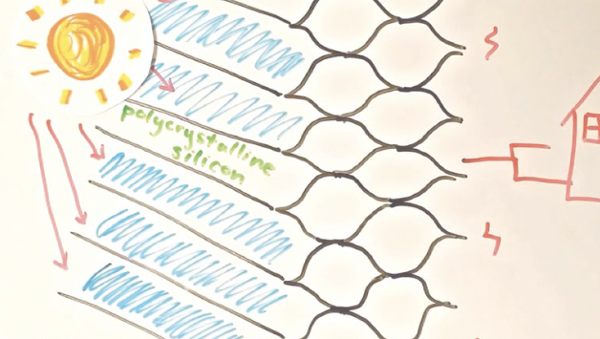 Figure 5. High efficiency solar cells, embedded in insulating blinds, capture energy.
Figure 5. High efficiency solar cells, embedded in insulating blinds, capture energy.
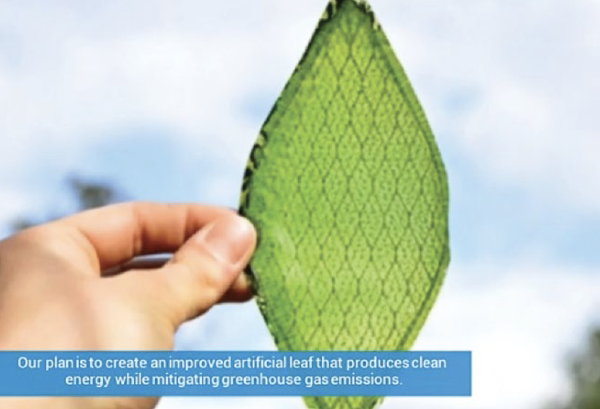 Figure 6. Artificial leaves mimic the process of photosynthesis to capture CO2.
Figure 6. Artificial leaves mimic the process of photosynthesis to capture CO2.
Conclusion
Understanding learning in the context of a science competition can help us understand the consequences of including such learning contexts in the ecosystem of school-based science.
Pat (a teacher who required her class to participate) wrote us in an email in 2015:
Initially, I thought that my students didn’t have time to compete and do all that we wanted them to […] I really have to praise my students for all the work they did on this project, the majority of which was outside of class. They’d discuss each other’s entries in the hall, including those from other schools, and really learned a lot about environmental issues. I am really hopeful that you plan to continue with the competition this year.
Offering a rich, real world challenge that can accommodate divergent thinking in a “knowledge community” builds critical social skills and cultural competencies for youth, e.g., collective intelligence (the ability to pool knowledge with others toward a common goal), judgment (the ability to evaluate the reliability and credibility of sources), and negotiation (the ability to “travel across diverse communities, discerning and respecting multiple perspectives, and grasping and following alternative norms”) (Jenkins 2009, p. 106).
The competition attracted and motivated teens to enter and resulted in sustained engagement in deep science learning. Taken together, our results show that teams crossed disciplinary boundaries as they chose concepts from chemistry, engineering, mathematics or biology to address the mitigation challenge. They addressed a wide diversity of topics ranging from biomimicry for artificial photosynthesis, to decarbonization of fossil fuels, to social media campaigns for reducing energy use, or improving transportation efficiency.
Upcoming Challenges
Visit the project website for details about upcoming challenges in 2020 and beyond.
Sign up to let us know about possible interest, and follow us on Facebook.
Download Hands On! Spring 2020
Acknowledgements
The authors would like to acknowledge the contributions of our TERC colleagues Abe Drayton and Santi Gasca, as well as the teachers, students, scientists, and other mentors who made the project come alive. We also wish to acknowledge the work of Joni Falk and the STEM for All Videohall team at TERC, whose Videohall hosted our pilot competitions.
Author Bios
Brian Drayton, Ph.D., co-directs the Center for School Reform at TERC. A plant ecologist working in science education since the 1980s, projects have included research and development on electronic communities of practice and on inquiry learning and technology use in secondary school classrooms. Other work (with Gillian Puttick and others), as part of the TERC Life Sciences Group includes curriculum development and research in life science, ecology, and climate change education. Current interests focus on the nature of communities as science educators, and on discourse processes and cognition about science and on processes of curriculum design.
Gilly Puttick, Ph.D., has a broad background in biology and biology education and has worked as an educational researcher and curriculum developer at TERC for almost 30 years. As a PI and co-PI, she has directed many federally funded education research and development projects, most recently focused on climate change education. She focuses her efforts on bringing fresh scientific discoveries to formal and informal settings through designing, developing and researching curriculum, programs, and activities for students and teachers. With Drayton, she is co-leader of the Life Sciences Group at TERC.
References
Aust, C., & Kinnick, K. (1996). Communicating scholarly research via the poster session: The experience at a national convention. Paper presented at the Annual Meeting of the Speech Communication Association, San Diego, CA.
Drayton, B. & Puttick, G. (2018). Innovate to Mitigate: Learning as activity in a team of high school students addressing a climate mitigation challenge. Sustainability in Environment 3, 1-25.
Falk, J., Stroud, R., Drayton, B., & Hobbs, K. (2012). Virtual poster competition: Benefits and drawbacks. Poster presented at the Annual Meeting of the American Educational Research Association, Vancouver, BC.
Johnson, G., & Green, R. (2007). Undergraduate researchers and the poster session. Journal of Instructional Psychology, 32, 117-119.
King, A, and Lakhani, K.R. (2013) Using open innovation to identify the best ideas. MIT Sloan Learning Research 13:11-29.
Puttick, G. & Drayton, B. (2017). Innovate to Mitigate: Science learning in an open-innovation challenge for high school students. Sustainability in Environment, 2, 389-418.
Sisak, M.E. (1997). Poster sessions as a learning technique, Journal of Chemical Education, 74, 1065-1067.
Stegemann, N., & Sutton-Brady, C. (2009). Poster sessions in marketing education: An empirical examination, Journal of Marketing Education, 31, 219-229.
Stroud, R., & Falk, J. (2015). Benefits of an Online Video Competition for Participants, Community Members, and the Public. Paper presented at NARST Annual Conference, Baltimore MD, April 2015.

